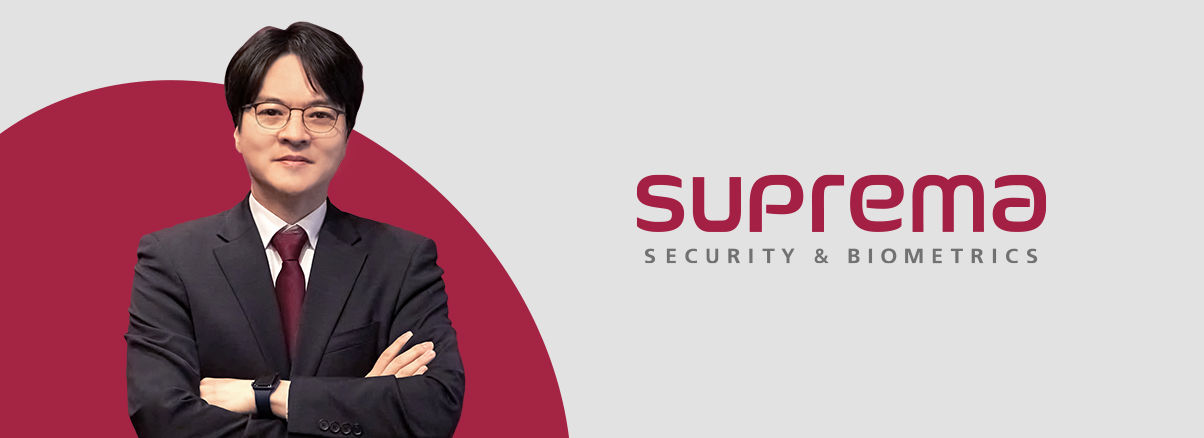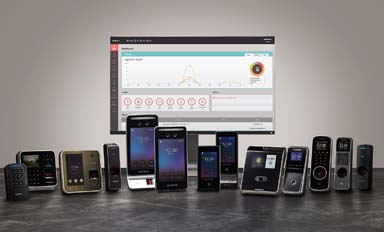- Latest press releases from Suprema

In this exclusive SafetyDetectives interview, we learn about Suprema Inc’s. AI security solutions with a focus on innovation and strategic vision. Suprema’s BioStar 2 platform and AI-based solutions have become industry benchmarks in biometric authentication. The company addresses privacy concerns by complying with data protection standards and emphasizing user consent with the term ‘Facial Authentication.’ Suprema’s integration of AI, particularly Neural Processing Units, sets it apart technically, ensuring high accuracy and speed in biometric authentication. Biometric technologies, such as facial and fingerprint recognition, are integral to access control systems, meeting the growing demand for contactless solutions. AI enhances security by improving anti-spoofing techniques, making biometric systems adaptable to dynamic landscapes.
Can you tell me about the CEO of Suprema?
Hanchul Kim, the CEO of Suprema Inc., a global AI security solution provider, is a forward-thinking leader who has ability to navigate dynamic market conditions and seizing expansion opportunities. His strategic mindset and unwavering dedication to innovation have firmly positioned Suprema as an industry leader. Under Hanchul Kim’s leadership, Suprema has consistently achieved remarkable business growth in global markets.
What are the core solutions and technologies that Suprema offers in the field of security and biometrics?
Suprema is revolutionizing the security landscape with its unified security platform and deep-learning based AI security solutions.
Suprema BioStar 2 is a web-based unified security platform designed with scalable and flexible architecture. This innovative system empowers organizations to elevate their security measures and streamline access control management by integrating various security features into one unified system. For example, BioStar 2 offers access control, time & attendance management, and real-time video monitoring in a single platform. Also, BioStar 2 is designed to meet the security needs of wide range of businesses, spanning from startups and small to medium-sized enterprises to large-scale operations like factories and corporate buildings.
Suprema BioStar 2 support the largest variety of multi-credentials in the entire industry, including fingerprint recognition, facial authentication, RFID card, PIN number, mobile access, QR code and barcode. Suprema’s another groundbreaking advancement includes the integration of an AI into access control solutions. Suprema BioStation 2a, AI-based fingerprint recognition access control solution, and BioStation 3, AI-based facial authentication access control solution, help to enhance security with the most accurate AI-based biometric recognition performance.
What are the biggest challenges currently facing the biometrics industry?
Biometric data is highly sensitive and personal. Issues related to unauthorized access, data breaches, and potential misuse of biometric information raise significant privacy concerns. Establishing robust security measures and ensuring compliance with privacy regulations are crucial.
To ensure the highest standards of data protection, Suprema’s software and hardware devices are meticulously designed and developed in compliance with ISO/IEC 27001, ISO/IEC 27701, and GDPR (General Data Protection Regulation). At every stage of product design and development, Suprema strictly adheres to GDPR, the world’s most stringent privacy and data protection law.
To showcase Suprema’s commitment to data privacy and security, Suprema announced terminology change to ‘Facial Authentication’ instead of ‘Facial Recognition’. Because ‘Facial Recognition’ identifies faces through detection and surveillance. However, ‘Facial Authentication’ emphasizes user consent. Suprema’s security ensures authentication only with explicit user agreement, setting us apart from passive recognition methods.
Adding to this, Suprema’s exclusive authentication method ‘Template on Mobile (ToM)’ securely stores facial templates on users’ smartphones, eliminates the need for reliance on company servers for biometric data storage. This mitigates the need to entrust companies with the protection of their sensitive biometric data and significantly aids organizations in achieving GDPR compliance by eliminating the necessity of storing users’ biometric data on central servers, thus decentralizing data management.
How does Suprema approach innovation in biometric technology?
For over two decades, Suprema has stood at the forefront of biometric access control since its establishment in 2000. With 23 years of accumulated field experience in biometric industry, Suprema possesses technical superiority in biometric access control. Suprema took another significant leap forward by integrating AI to Suprema’s innovative biometric access control technology.
Suprema excels in optimizing AI engines and edge devices. Leveraging Suprema’s extensive field data, Suprema has developed a distinctive capability in camera and image optimization, and in effectively training vast datasets for deep learning. Moreover, Suprema has pioneered on-device AI for biometric access control with its own technology. Traditionally, running AI algorithm requires expensive CPUs and extensive memory. However, by adopting AI processor —specifically, the Neural Processing Unit (NPU) optimized for deep learning—Suprema edge devices efficiently run AI algorithms, processing large volumes of data while preventing overheating and hardware slowdowns. This positioned Suprema as the world’s first company to adopt deep learning technology into biometric authentication. Deep learning-based AI algorithm can be trained to extract minutiae points with a high degree of precision. Suprema’s AI edge devices including BioStation 2a, and BioStation 3, ensure unparalleled performance in terms of accuracy and speed, setting new standards for biometric authentication.
How are biometric technologies being integrated into access control systems?
Biometric technologies are being integrated into access control systems to enhance security by adding an extra layer of verification. Unlike regular access control systems that use access cards and/or codes, a biometric access control system uses a person’s physical traits such as their fingerprints, face, palm veins, and iris. Biometric access control is generally recognized as a common way to secure highly restricted areas within a building. Biometric credentials can be used as the only form of identification or used with other credentials to support multi-factor authentication (MFA). Setting MFA for a biometric security measure provides an even stronger level of protection for high-security areas.
There was an increased demand for contactless biometric systems, especially facial recognition, during the Covid-19, and this trend continues until now. Fingerprint recognition and facial authentication are the most popular biometric technologies implemented in various devices, such as smartphones, laptops, access control systems, identity verification tools, and payment. This indicates that biometrics offer high security, convenience, and user acceptance. As a result, the adoption of biometrics in the security market, where Suprema is a leading player, will expand further.
How is artificial intelligence enhancing biometric technologies?
Artificial Intelligence (AI) plays a pivotal role in elevating biometric technologies by introducing advanced automation and intelligence into access control systems. Its capacity to efficiently handle large-scale biometric datasets, automate intricate tasks, and mitigate evolving security complexities marks a significant stride. AI’s analytical precision in biometric data discernment results in heightened recognition accuracy, detecting nuanced patterns that conventional algorithms may overlook. Moreover, AI’s learning capability from past discrepancies ensures continual algorithm refinement, thereby enhancing the overall performance of biometric systems. Additionally, AI can improve anti-spoofing techniques. With the ability of AI to analyze large dataset, continuous learning, and real-time processing, the accuracy in detecting fake faces or fingerprints, images, and photos will increase. Consequently, these advancements contribute to the creation of robust and adaptive security measures to protect against various types of biometric spoofing attempts. This integration of AI not only provides unparalleled intelligence but also endows biometric systems with adaptability, allowing them to thrive in dynamic and challenging security landscapes.
Source: SafetyDetectives











